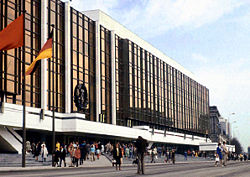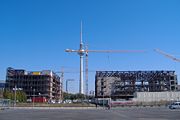Palast der Republik
| Palast der Republik | |

The Palast der Republik in the 1980s. |
|
| Information | |
|---|---|
| Location | Berlin, Germany |
| Coordinates | 52° 31' 3" N, 13° 24' 10" O |
| Status | Under Deconstruction |
| Constructed | 1973 - 1976 |
| Opening | April 23, 1976 |
| Demolished | Expected in late 2008 |
| Companies | |
| Architect | Heinz Graffunder and Karl-Ernst Swora |
The Palast der Republik (Palace of the Republic) was a building in Berlin, on the bank of the River Spree between Schloßplatz and the Lustgarten (both referred to jointly as Marx-Engels-Platz from 1951 to 1994). It served primarily as the seat of the East German parliament, the Volkskammer, but it also housed two large auditoriums, art galleries, restaurants and a bowling alley.
Contents |
History
Construction
The Palast was constructed from 1973 to 1976 in the prevailing architectural style for East German buildings, using bronze mirrored windows. The grand opening ceremony was held on April 23, 1976, and the building was opened to the public two days afterwards on April 25, 1976. It was built on the site of the former Berlin Stadtschloss (Berlin City Palace), which was damaged during World War II, but eventually demolished by the government authorities in 1950, as they regarded it a symbol of Prussian imperialism.
Once opened, the building was sometimes nicknamed "Ballast der Republik" ("Ballast of the Republic"), "Erichs Lampenladen" ("Erich's Lamp Shop", referring to the then incumbent Erich Honecker and the 1001 lamps hanging in the foyer), "Edeka - Erichs Datsche am Kanal" ("Erich's dacha at the Canal") or "Palazzo Prozzo."
Asbestos contamination
Just prior to German reunification in October, 1990, the structure was found to be contaminated with asbestos, and was closed to the public on September 19, 1990 by decree of the Volkskammer. By 2003, all the asbestos had been removed along with internal and external fittings allowing safe deconstruction.
Demolition

Despite some minor resentment felt by some East Germans[1], in November, 2003, the German parliament decided to demolish the building and leave the area as parkland until funding for the reconstruction of the Berlin City Palace could be found. This action was endorsed by most of the populace, specially among West Germans, who considered the Palast to be too closely associated with the reviled East German (GDR) regime[1]. Demolition started on February 6, 2006, and was scheduled to last about fifteen months at a cost of twelve million euros. The demolition lasted longer than scheduled because of hazards to neighboring buildings. Dismantling of the structure was seriously delayed after more asbestos was discovered in various locations, and the estimated completion date was pushed back to the end of 2008. About 35,000 tonnes of steel that once held this building together are now being shipped to the U.A.E. to be used for the construction of the Burj Dubai. [1]
Future development
In 2007, the Bundestag definitively voted for the Prussian era Stadtschloss to be rebuilt. Three façades of the palace will be exact replicas the original, but the interior will be a modern one. The new palace will be called the Humboldtforum, and will house the Humboldt collection and gallery of non-European art.
Noteworthy events held at the Palast
Some of the most noteworthy events hosted at the Palast der Republik included the party congresses of the Socialist Unity Party (SED) and the state gala on the eve of the 40th anniversary of the German Democratic Republic in October, 1989, at which Soviet leader Mikhail Gorbachev was present. In October 1983, the West German rock star, Udo Lindenberg, was permitted to perform in concert at the Palast der Republik. At the concert, Lindenberg sang one of his best-known songs, Sonderzug nach Pankow ("Special Train To Pankow"), which satirized East German leader Erich Honecker, and which he had been asked not to play. The parties of the SV Dynamo regularly took place here.
The shell of the building was opened for visitors in mid-2003, and a pressure group campaigned for temporary use of the building for cultural events until its eventual demolition. Beginning in early 2004, the building was used for events such as housing an exhibition of the Terracotta Army and a special concert by the famous Berlin-based band Einstürzende Neubauten.
External links
- Brokedown Palast — documentary film about the destruction of the Palast (in English)
- Palast der Republik, at Schlossplatz, Historic Centre of Berlin (in German, with pictures)
- Zwischenpalastnutzung (Temporary Palace Use) (in German)
- Documentary at Frontline/World (in English)
- A site about the Palace (in English)
- Berlin webcam with view of the Palast der Republik
- About the Palace in Berlin (German with a lot of pictures)
- Volkspalast, Special Prize of the Jury of the European Prize for Urban Public Space 2006
- fensterzumhof.eu: Deconstruction of the Volkspalast (Photo Series)
References
- ↑ 1.0 1.1 1.2 Berlin's Demolished Socialist Palace is Revived in Dubai, Deutsche Welle, 2008-08-11, http://www.dw-world.de/dw/article/0,2144,3554502,00.html, retrieved on 2008-08-13